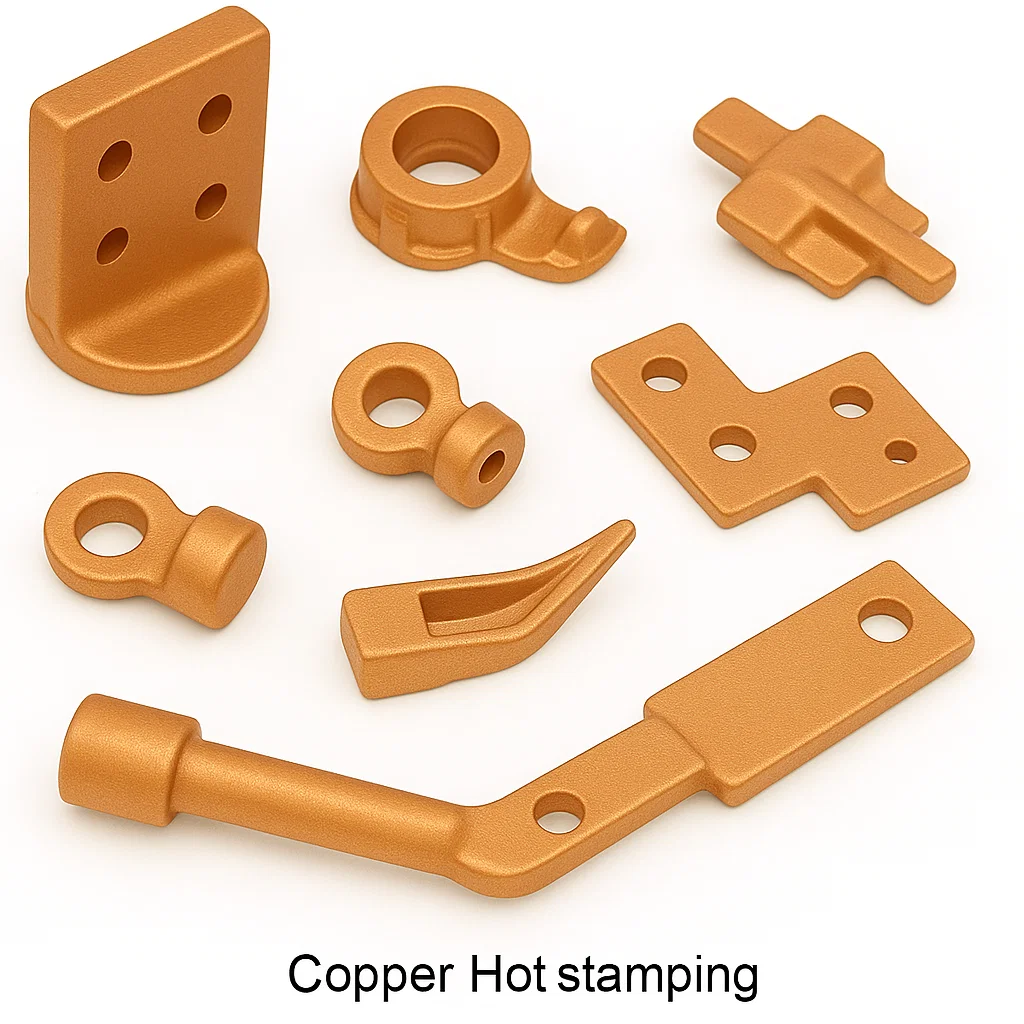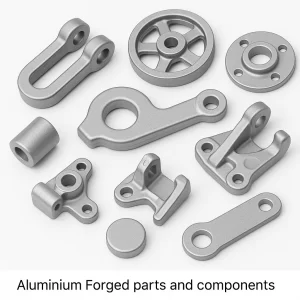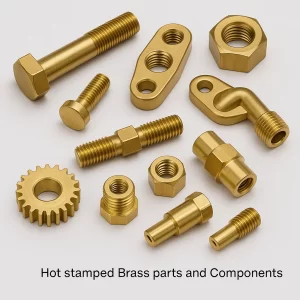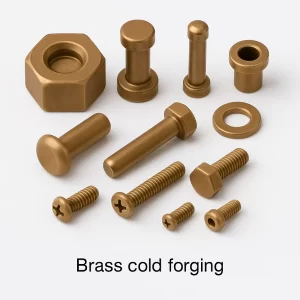Copper Hot Stamping | Copper Dies for Hot Foil Stamping | Hot Stamping Manufacturer India
Comprehensive Overview of Copper Hot Stamping
We are one of the leading manufacturers and suppliers of Copper Hot Stamping Dies, Copper Foil Stamping Tools, Hot Stamping Services, and Copper Engraving Solutions from India. We provide high-quality copper hot stamping dies, copper magnesium dies, copper embossing plates, hot foil stamping services, copper marking tools, precision engraved copper dies, and custom hot stamping solutions to diverse industries worldwide. Our facility specializes in producing premium copper dies and hot stamping services using advanced CNC engraving, chemical etching, electroforming, photoengraving, laser engraving, die mounting, and comprehensive quality control systems. We serve diverse industries including packaging and printing (luxury packaging, cosmetics, food/beverage, pharmaceuticals), leather goods (handbags, wallets, belts, footwear), textiles and apparel (labels, tags, garment decoration), publishing (book covers, certificates, invitations), automotive (interior trim, badges, nameplates), electronics (product branding, serial numbers), promotional products (corporate gifts, awards, stationery), and decorative applications (greeting cards, premium labels, security printing). Our expertise encompasses various copper die types including Pure Copper Dies (99.9% Cu for fine detail), Copper Magnesium Alloy Dies (lightweight for rotary machines), Brass Dies (economical alternative), Copper-Backed Dies (steel base with copper face), different die making methods including CNC engraving (3D relief, complex designs), chemical etching (fine line work), electroforming (highest detail reproduction), and various applications including metallic foil stamping (gold, silver, copper, holographic), blind embossing (raised relief without foil), combination stamping (foil + emboss), multi-level embossing, achieving line width resolution 0.05-0.5mm, depth precision ±0.01-0.05mm, durability 100,000 to 5,000,000+ impressions, compliance with packaging industry standards, and reliable high-quality decorative finishing for luxury packaging, leather goods, and premium printed materials.
Copper Hot Stamping Process Overview
What is Hot Stamping?
Definition: Hot stamping (also called hot foil stamping or foil blocking) is a dry printing process where metallicized or pigmented foil is transferred to a substrate using heat, pressure, and a metal die (typically copper or brass). Process: Heated copper die (80-150°C typical) presses foil against substrate, heat and pressure release foil’s coating layer from carrier film, metallic or pigmented layer adheres to substrate creating permanent decorative impression. Result: Brilliant metallic finish (gold, silver, copper, holographic), raised embossed effect possible (combined stamping), durable long-lasting decoration.
Hot Stamping vs. Other Decoration Methods
Versus Printing: Hot stamping creates true metallic shine (not printed simulation), more durable and scratch-resistant, luxurious tactile feel, higher perceived value. Versus Labeling: Integrated decoration (not applied label), cannot peel or separate, cleaner appearance, suitable for irregular surfaces. Versus Pad Printing: More durable finish, metallic effects superior, better for flat/gently curved surfaces, higher setup cost but better quality.
Types of Copper Dies for Hot Stamping
Pure Copper Dies (Electrolytic Copper)
Material: 99.9% pure electrolytic copper, excellent thermal conductivity. Thickness: 3-10mm typical depending on size and application. Properties: Superior heat transfer (401 W/m·K), excellent engraving characteristics, fine detail capability (line width 0.1-0.5mm), hardness 40-90 HV (soft, requires careful handling). Applications: Fine line work and intricate detail, luxury packaging with complex patterns, cosmetic packaging logos and text, leather embossing detailed designs, security printing micro-text. Durability: 100,000-500,000 impressions depending on detail and substrate, requires careful handling (soft material damages easily). Cost: Premium material cost.
Copper Magnesium Alloy Dies
Material: Copper with 0.5-1.5% magnesium addition, harder than pure copper. Properties: Improved wear resistance versus pure copper, lighter weight for rotary applications, adequate thermal conductivity, hardness 80-120 HV. Applications: Rotary hot stamping (high-speed packaging lines), continuous web stamping, medium-run production 500,000-2,000,000 impressions, flexible packaging decoration. Advantages: Longer die life than pure copper, weight reduction important for rotary cylinders, economical for medium-high volume. Cost: Moderate premium over pure copper.
Brass Dies (Copper-Zinc Alloy)
Material: Brass (60-70% Cu, 30-40% Zn), harder than copper. Properties: Good thermal conductivity (lower than pure copper), higher hardness 100-150 HV, more durable for long runs, economical material cost. Applications: Simple designs without fine detail, long production runs >1,000,000 impressions, economical alternative to copper for basic work, textile label stamping. Limitations: Lower thermal conductivity affects foil release, not suitable for very fine detail <0.3mm, less forgiving than copper for complex dies. Cost: Most economical die material.
Copper-Backed Steel Dies
Design: Steel base (3-6mm) with copper facing (1-3mm), combines steel strength with copper thermal properties. Advantages: Steel provides dimensional stability and durability, copper face provides excellent heat transfer, suitable for very long runs 2,000,000-5,000,000+ impressions, resistant to warping under high pressure. Applications: High-volume production runs, large-area stamping requiring stability, heavy-pressure applications, automotive interior trim stamping. Cost: Higher initial cost justified by extended die life.
Magnesium Dies (Alternative)
Material: Magnesium alloy, very lightweight. Properties: Lowest weight for rotary applications, adequate thermal conductivity, lower cost than copper, hardness 40-60 HB. Applications: High-speed rotary stamping where weight critical, temporary or short-run production, prototyping and sampling. Limitations: Shortest die life (50,000-200,000 impressions), prone to oxidation (requires protective coating), lower detail resolution than copper. Cost: Most economical die option.
Copper Die Manufacturing Methods
CNC Engraving (Mechanical Engraving)
Process: Computer-controlled engraving machine mills copper die using diamond or carbide cutters, removes material creating recessed areas (intaglio) or raised areas (relief), multi-axis capability (3D engraving). Equipment: 3-5 axis CNC engraving machines, spindle speeds 10,000-40,000 RPM, positioning accuracy ±0.01-0.02mm. Capabilities: Line width 0.1-0.5mm minimum, depth control 0.05-10mm, 3D relief engraving creating depth variation, complex geometric patterns, text and logos. Advantages: Fast turnaround 2-5 days depending on complexity, economical for small quantities and prototypes, design changes easy (re-engrave), suitable for both relief (embossing) and intaglio (debossing). Applications: Leather embossing dies (deep relief 0.5-3mm), packaging dies medium detail, prototypes and short-run dies, multi-level embossing. Limitations: Not finest detail possible (chemical etching finer), visible tool marks on very fine work, limited to 2.5D or 3D (not fine flat work). Cost: Moderate, economical for low-medium volumes.
Chemical Etching (Photoengraving)
Process: Photoresist applied to copper sheet, artwork photographically exposed creating resist pattern, acid etching removes unprotected copper, resist stripped revealing etched die. Depth: Shallow etching 0.1-1mm typical, fine line capability 0.05-0.2mm minimum. Capabilities: Finest line work and detail, half-tone patterns possible, uniform etch depth across large areas, suitable for flat artwork (logos, text, patterns). Advantages: Excellent detail resolution (finest method), uniform etch quality, economical for flat artwork, multiple dies from single artwork. Applications: Fine text and line work (<0.2mm), security printing features, holographic patterns, flat logos without relief, printed circuit board dies (specialty). Limitations: Shallow depth only (not deep embossing), limited 3D capability, chemical waste management required, slower than CNC (5-10 days typical). Cost: Moderate to high depending on detail.
Electroforming (Electroplating)
Process: Master pattern created (often by CNC or chemical etching), conductive coating applied to master, copper electroplated onto master (100-500 microns per hour), thick copper shell built up (3-10mm total), shell separated from master creating die, backed with resin or metal for rigidity. Capabilities: Highest detail reproduction (exact copy of master), finest detail possible 0.01-0.05mm, perfect reproduction of textures and fine features, sharp edges and fine points. Advantages: Ultimate detail and quality, reproduces textures (leather grain, fabric weave), multiple dies from single master, consistent quality die-to-die. Applications: Luxury packaging highest-quality work, cosmetics premium branding, security printing fine detail, leather exotic textures, holographic patterns exact reproduction. Limitations: Longest lead time (2-4 weeks), highest cost method, requires master creation first, complex process. Cost: Premium (2-5× CNC engraving).
Laser Engraving
Process: High-power laser (CO2 or fiber laser) ablates copper surface, computer-controlled scanning creates pattern, vaporizes material creating recessed or textured areas. Depth: Shallow engraving 0.05-0.5mm typical. Capabilities: Very fine detail 0.05-0.1mm, complex patterns and gradations, fast processing 1-3 days, no tool wear (laser is contactless). Applications: Serial numbers and variable data, QR codes and barcodes, texture creation (matte, satin finishes), prototyping and short runs. Limitations: Shallow depth only, can create rough surface texture (requires post-processing), limited 3D capability. Cost: Moderate, fastest turnaround.
Pantograph Engraving (Traditional)
Process: Mechanical copy system following master pattern, stylus traces master while cutter proportionally engraves copper die, reduction or enlargement possible. Status: Largely obsolete (replaced by CNC), still used for artistic and specialty applications, traditional typography and lettering. Advantages: Traditional craftsmanship aesthetic, suitable for classic letterpress-style work. Limitations: Slow manual process, limited accuracy versus CNC, requires skilled operator.
Hot Foil Stamping Materials
Metallic Foils
Gold Foil: Available in shades (pale gold, rich gold, antique gold, rose gold), most popular metallic foil for luxury packaging, cosmetics, invitations. Silver Foil: Bright silver, matte silver, holographic silver, modern clean appearance. Copper Foil: Warm metallic tone, vintage/rustic aesthetic, growing popularity craft and artisan products. Other Metallics: Bronze, pewter, champagne, custom metallic colors. Construction: Polyester carrier film (12-25 microns), release layer, metallic layer (aluminum vacuum-deposited), color layer, adhesive layer (heat-activated).
Pigment Foils (Non-Metallic)
Colors: Full color range available (red, blue, green, black, white, pastels, fluorescents). Finishes: Gloss, matte, satin, pearl, interference colors. Applications: Color accent without metallic shine, multi-color designs (sequential stamping), black text and solid areas, white on dark substrates. Advantage: Opaque coverage, consistent color, durable.
Holographic and Special Effect Foils
Holographic: Rainbow holographic, micro-embossed patterns, diffraction gratings, security features. Special Effects: Brushed metal, cracked glass, wood grain, marble patterns, iridescent, color-shift. Applications: Security packaging (anti-counterfeiting), premium product differentiation, eye-catching designs, brand protection.
Foil Selection Factors
Substrate Compatibility: Different foils for paper, leather, plastic, fabric, metal, each substrate requires specific adhesive formulation. Temperature Range: Standard foils 80-120°C, high-temperature foils 120-180°C (plastics, coated papers), low-temperature foils 60-90°C (heat-sensitive substrates). Adhesion Requirements: Permanent adhesion (most applications), removable adhesion (promotional/temporary), food-safe adhesion (food packaging contact).
Hot Stamping Applications by Industry
Packaging and Printing
Luxury Packaging: Cosmetics boxes (perfume, makeup, skincare), jewelry boxes and pouches, premium wine and spirits packaging, gift boxes high-end products. Details: Gold/silver logos and brand names, decorative borders and patterns, multi-level embossing creating depth, holographic security features. Volumes: Short to medium runs (1,000-100,000 pieces), emphasis on quality and appearance, justifies hot stamping cost premium.
Food and Beverage: Chocolate boxes and wrappers, coffee and tea premium packaging, gourmet food products, specialty confectionery. Common: Gold and copper foils creating premium appeal, embossed logos and text, FDA-compliant food-safe foils for direct contact.
Pharmaceutical: Medicine packaging boxes, vitamin and supplement containers, medical device packaging, prescription medication cartons. Requirements: Durable decoration (handling resistance), compatible with pharmaceutical printing, security features (holographic foils), regulatory compliance labeling.
Leather Goods and Accessories
Handbags and Purses: Brand logos hot stamped on leather, decorative patterns and borders, metal plate embossing, personalization (initials, names). Common Foils: Gold, silver, blind embossing (no foil – debossed), copper and rose gold trending. Die Types: Deep relief copper dies 0.5-2mm depth, 3D sculptured logos, combination flat and relief.
Wallets and Small Leather: Brand stamps, decorative corner details, monogramming services, interior stamping. Volume: High volume production (10,000-1,000,000+ pieces annually), requires durable copper-magnesium or brass dies.
Footwear: Insole branding and logos, heel stamps, decorative shoe uppers, tongue labels. Challenges: Curved surfaces requiring flexible die mounting, heat-sensitive adhesives (don’t damage leather), consistent pressure on irregular surfaces.
Belts and Straps: Decorative end stamps, logo branding, personalization, border patterns. Process: Flat stamping on belt leather, cylindrical stamping on tubular straps.
Textiles and Apparel
Labels and Tags: Woven label hot stamping (gold/silver on fabric), hang tags luxury brands, care instruction labels, size labels decorative. Substrates: Polyester satin ribbon, cotton twill tape, synthetic woven fabrics. Temperature: Low-temperature foils 80-120°C (fabric tolerance).
Garment Decoration: T-shirt and apparel branding, jeans leather patches, jacket embellishments, athletic wear logos. Methods: Direct fabric stamping (heat transfer paper alternative), leather patch stamping (sewn onto garment), combination embroidery and foil.
Publishing and Stationery
Book Covers: Hardcover books title and author stamping, decorative borders and patterns, publisher logos, special editions premium finishes. Classic: Gold foil on leather or cloth bindings, blind embossing creating depth, combination foil and emboss (most luxurious).
Certificates and Diplomas: Gold borders and seals, official stamps and emblems, recipient name personalization, security features (holographic foils).
Invitations and Greeting Cards: Wedding invitations (most common hot stamping application), holiday cards premium, announcement cards (birth, graduation), business cards high-end. Aesthetic: Gold and silver most popular, copper and rose gold trending, blind embossing elegant understated.
Automotive and Transportation
Interior Trim: Dashboard badges and logos, door sill plates, steering wheel emblems, gear shift plates. Materials: Plastic (ABS, PC, PP), vinyl/leather surfaces, metal (aluminum, steel) with special foils. Requirements: Heat resistance (interior temperatures), UV resistance (sunlight exposure), abrasion resistance (frequent contact).
Nameplates and Badges: Vehicle identification plates, model designation badges, serial number plates, safety and warning labels. Durability: Outdoor weathering resistance, long-life requirement 10-20 years, automotive-grade foils.
Electronics and Appliances
Product Branding: Laptop logos, phone decorative elements, appliance control panels, audio equipment faceplates. Substrates: Plastic (ABS, polycarbonate, acrylic), metal (aluminum, stainless steel), glass (with primer). Challenges: Heat-sensitive plastics requiring low-temperature foils, curved surfaces (cylindrical stamping), small text and fine detail.
Serial Numbers and Data Plates: Equipment identification plates, compliance labels (UL, CE, safety), QR codes and barcodes, variable data stamping. Method: Laser-engraved copper dies for variable data, sequential numbering systems, heat-resistant foils for durable marking.
Advantages of Copper Hot Stamping
Superior Quality and Appearance
Metallic Brilliance: True metallic shine (not printed simulation), reflective surface catching light, premium luxury appearance, higher perceived product value +30-100%. Detail Reproduction: Fine lines and small text 0.1-0.5mm, intricate patterns and filigree, sharp edges and clean definition, exact brand logo reproduction.
Depth and Dimension: Multi-level embossing creating 3D relief, combination foil plus emboss, tactile quality and texture, blind embossing (debossing) subtle elegant effect.
Durability and Permanence
Abrasion Resistance: Foil layer durable versus printing ink, scratch-resistant metallic finish, handling and shipping resistant, retail shelf-life stability. Environmental Resistance: UV resistant (no fading in sunlight), moisture resistant (no water damage), chemical resistant (no solvent damage), temperature stable (hot/cold exposure).
Longevity: Permanent decoration (decades lifespan), no peeling or flaking (properly applied), leather goods lifetime durability, archival quality for books and documents.
Versatility and Flexibility
Substrate Range: Paper and paperboard (all types), leather (natural and synthetic), fabric (woven and non-woven), plastic (most thermoplastics), metal (with primers), wood and wood veneer. Design Freedom: Any artwork convertible to die, color options unlimited (foil colors), combination techniques (foil + print + emboss), security features integration.
Production Flexibility: Short runs economical (100-1,000 pieces), medium runs standard (1,000-100,000 pieces), high volume possible (>100,000 pieces), personalization and variable data.
Cost-Effectiveness for Premium Products
Value Proposition: Adds significant perceived value for modest cost increase, premium pricing justified by hot stamping, brand differentiation from competitors, luxury market positioning. Return on Investment: Tooling cost $200-$2,000 amortized over production, foil cost $0.01-$0.50 per impression depending on area, labor cost low (automated process), versus alternative decoration methods competitive for quality level.
Copper Die Design Guidelines
Design Considerations
Line Width: Minimum 0.15-0.3mm for reliable reproduction (thinner possible with chemical etching/electroforming but risky), positive elements (raised) minimum 0.2mm, negative elements (recessed) minimum 0.3mm. Text Size: Minimum 6-8 point for serif fonts, minimum 5-6 point for sans-serif fonts, avoid very thin strokes <0.15mm, reverse text (white on foil background) requires larger sizing.
Relief Depth: Shallow embossing 0.1-0.5mm (combined with foil), medium embossing 0.5-1.5mm (dimensional effect), deep embossing 1.5-5mm (leather, heavy board), blind embossing 0.3-2mm typical (no foil).
Detail Spacing: Minimum 0.3-0.5mm spacing between elements, avoid large solid areas (foil wrinkling, uneven coverage), break up large areas with texture or patterns, border and frame width 1-3mm typical.
Technical Requirements
Artwork Format: Vector artwork preferred (AI, EPS, PDF), high-resolution raster acceptable 1200+ DPI for conversion, black and white (grayscale for depth variation in 3D), scale 1:1 actual size or clearly noted scale. Die Orientation: Intaglio (recessed/female die) for embossing raised image, relief (raised/male die) for debossing recessed image, combination dies possible (multiple levels).
Registration: Registration marks for multi-color or multi-stage stamping, alignment tolerance ±0.3-0.5mm, critical for precise overlay, color-to-color registration ±0.5mm achievable.
Substrate Considerations
Paper/Board: Thicker substrates emboss better (300+ GSM), coated papers require higher temperatures, porous uncoated papers easier foil adhesion, avoid highly textured surfaces (uneven stamping). Leather: Natural leather embosses deeply and beautifully, synthetic leather varies (PU embosses well, PVC less), test stamping recommended for leather batches, moisture content affects embossing (6-12% ideal).
Plastic: Thermoplastics soften under heat (embossing possible), heat-sensitive materials require low-temperature foils <100°C, curved surfaces require special techniques, test critical for plastic materials.
Quality Control and Testing
Die Inspection
Dimensional Verification: Measure line widths and spacing with microscope or optical comparator, verify depth with depth gauge or profilometer, check overall dimensions versus artwork. Surface Quality: Inspect for burrs or rough edges (polish as needed), verify sharp detail reproduction, check thermal conductivity uniformity (no voids or inclusions).
Proofing: Test stamping on actual substrate, verify foil release and adhesion, check embossing depth and quality, adjust temperature, pressure, dwell time as needed.
Production Quality Control
First Article Inspection: Verify initial production pieces before full run, check all dimensions and artwork details, confirm foil color and finish correct, approve before proceeding. In-Process Monitoring: Visual inspection every 100-500 pieces, check foil coverage completeness (no skips or voids), verify emboss depth consistency, monitor foil consumption rate.
Adhesion Testing: Tape test (foil adhesion to substrate), scratch resistance testing, wash testing for leather and fabric, aging tests for durability verification.
Final Inspection: 100% visual inspection for defects, random sampling detailed inspection, packaging inspection preventing damage, documentation and lot traceability.
Why Choose Our Copper Hot Stamping Services
Three Decades of Experience
Established 1990: 30+ years providing copper dies and hot stamping services for packaging, leather, printing industries across 25+ countries. Expertise: Comprehensive die making (CNC, chemical etching, electroforming, laser), hot stamping production services, design consultation and optimization. Quality: 99% first-pass approval rate, <0.5% defect rate production, customer satisfaction emphasis.
Complete Die Making Capabilities
All Methods: CNC engraving (fast economical 2-5 days), chemical etching (finest detail 5-10 days), electroforming (highest quality 2-4 weeks), laser engraving (rapid prototyping 1-3 days). All Materials: Pure copper 99.9%, copper-magnesium alloy, brass dies economical, copper-backed steel long runs. All Sizes: Small dies 10×10mm to large 500×500mm, custom dimensions per requirement.
Hot Stamping Production Services
In-House Stamping: Platen stamping machines for flat substrates, rotary stamping for web materials, cylindrical stamping for bottles and tubes. Substrate Range: Paper/board all types, leather natural and synthetic, fabric woven and non-woven, plastics most thermoplastics. Volumes: Short runs 100-1,000 pieces (prototypes, limited editions), medium runs 1,000-100,000 pieces (standard production), high volume >100,000 pieces (automated lines).
Design and Engineering Support
Design Consultation: Artwork optimization for hot stamping, line width and detail verification, emboss depth recommendations, substrate compatibility guidance. Prototyping: Sample dies and stamping before production tooling, multiple design iterations, test different foils and substrates. Technical Support: Temperature and pressure optimization, troubleshooting quality issues, process improvement recommendations.
Quality Assurance
Die Quality: Dimensional inspection ±0.05mm, surface finish verification, test stamping approval before shipment. Production Quality: First article inspection, in-process monitoring, adhesion testing, final inspection documentation. Certifications: ISO 9001:2015 quality management, packaging industry approved, leather industry certified.
Competitive Pricing
Cost Advantage: 30-40% savings versus European/North American suppliers, competitive with Asian suppliers superior quality and service. Transparent Pricing: Die making $200-$2,000 depending on size/method/complexity, production stamping $0.02-$0.50 per impression depending on area and volume, foil cost included or quoted separately. Volume Discounts: Production runs >10,000 pieces: 20-30% discount, >100,000 pieces: 30-40% discount.
Fast Turnaround and Global Service
Lead Times: CNC engraved dies 3-5 days, chemically etched dies 7-10 days, electroformed dies 2-4 weeks, production stamping 1-3 weeks after die approval. Worldwide Shipping: Export to 25+ countries, secure packaging preventing die damage, courier services 3-5 days international. Support: Technical support throughout project, quality troubleshooting, repeat orders expedited.
Frequently Asked Questions
Q1: What is the difference between CNC engraving and chemical etching for copper dies? CNC Engraving: Mechanical milling removes copper, fast turnaround 2-5 days, economical $200-$800 depending on size/complexity, suitable for medium detail (line width 0.15-0.5mm), excellent for 3D relief and deep embossing 0.5-5mm, ideal for leather embossing and dimensional effects. Chemical Etching: Acid etching removes copper, slower 7-10 days, moderate cost $400-$1,500, finest detail possible (line width 0.05-0.2mm), shallow depth 0.1-1mm only, ideal for fine line work, small text, intricate patterns. Selection: CNC for deep embossing/3D relief/fast turnaround, chemical etching for finest detail/flat artwork, electroforming for ultimate quality (highest cost).
Q2: How long does a copper hot stamping die last? Pure Copper Dies: 100,000-500,000 impressions depending on substrate hardness and detail complexity, paper/board substrates longest life, leather medium life (abrasive), plastics vary (hard plastics wear dies faster). Copper-Magnesium Dies: 500,000-2,000,000 impressions (harder than pure copper), suitable for medium-high volume production. Brass Dies: 1,000,000-3,000,000 impressions (hardest common die material), economical for long production runs. Copper-Backed Steel: 2,000,000-5,000,000+ impressions (most durable), justified for very high volume production. Factors Affecting Life: Substrate abrasiveness (coated paper easiest, leather/plastic harder), stamping pressure and temperature, die maintenance (cleaning, proper storage), design complexity (fine detail wears faster than bold).
Q3: What minimum line width and text size can be hot stamped? Line Width: CNC engraving minimum 0.15-0.3mm reliable (0.1mm possible but risky), chemical etching minimum 0.05-0.15mm (finest method), electroforming minimum 0.05-0.1mm (ultimate detail). Text Size: Serif fonts minimum 6-8 point (avoid thin serifs <0.15mm), sans-serif fonts minimum 5-6 point, bold fonts smaller sizing possible 4-5 point, reverse text (white on metallic) requires +1-2 points larger. Factors: Substrate affects minimum (smooth paper finest detail, textured leather/fabric larger required), foil type (some foils release finer than others), stamping pressure and temperature optimization. Recommendation: Provide artwork for evaluation, we recommend safe minimum sizing for your specific substrate and design, test stamping verifying before production tooling.
Q4: Can hot stamping be done on curved or irregular surfaces? Yes, with Limitations: Gently curved surfaces possible with flexible die mounting (bottles, tubes cylindrical), compound curves more challenging (special tooling/techniques), flexible silicone dies for irregular shapes. Cylindrical Stamping: Rotary hot stamping for bottles/tubes/cans, cylindrical dies mounted on heated cylinder, continuous or indexed stamping. Limitations: Very tight curves difficult (foil wrinkling), sharp edges and deep recesses challenging (uneven pressure), large curved areas may require multiple passes. Solutions: Flexible die mounting adapting to contours, heat-resistant transfer tape method (preheat transfer onto curved surface), specialized machines for specific shapes (bottle labelers, tube markers). Recommendation: Provide sample parts or detailed drawings, we evaluate feasibility and recommend optimal method.
Q5: What are typical costs for copper dies and hot stamping production? Die Making Costs: CNC engraved copper die $200-$800 depending on size 50×50mm to 200×200mm and complexity, chemically etched die $400-$1,500 (fine detail premium), electroformed die $1,000-$3,000 (highest quality), large dies >200mm add 30-50%, complex 3D relief add 20-40%. Production Stamping Costs: Small area <10 cm² $0.02-$0.10 per impression depending on volume, medium area 10-50 cm² $0.10-$0.30 per impression, large area >50 cm² $0.30-$0.50+ per impression, volumes >10,000 pieces reduced rates 30-40%. Foil Costs: Included in stamping price or quoted separately, standard metallic foils economical, holographic and specialty foils premium +50-100%. Minimum Order: Die making no minimum (single die acceptable), production stamping minimum 100-500 pieces economical (setup cost amortization). Comparison: Die cost one-time investment amortized over production, versus printing plates (similar cost but less durable appearance), versus labels (ongoing cost every piece, hot stamping more economical >5,000 pieces).
Contact Us – Request Quote for Copper Hot Stamping
Request a Quote: Send artwork (AI, EPS, PDF vector or high-res image), specify substrate (paper/leather/fabric/plastic), quantity (prototype/production volume), foil color preference (gold/silver/copper/holographic/color), embossing requirements (flat/relief/depth) to sales@jambrass.com for quotation within 24-48 hours.
Die Making Inquiry: Email artwork for die making method recommendation (CNC/chemical etch/electroforming), size and complexity assessment, turnaround time estimate, cost quotation.
Technical Support: Design optimization consultation, minimum line width verification, substrate compatibility questions, sample stamping requests.
Call Us: +91-22-43449300 / +91-22-43449323 (Monday-Saturday, 9:00 AM – 6:00 PM IST)
Office: 1406, 14th Floor, Dalamal Tower, Nariman Point, Mumbai – 400021, India
Factory: Plot 10B, GIDC Industrial Estate, Shanker Tekari, Udyognagar, Jamnagar, Gujarat – 361004
Contact: Mr. Mehul Vora | Email: sales@jambrass.com




